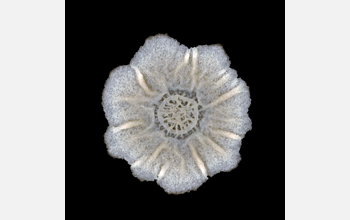Multimedia Gallery
Bacillus subtilis colony
A view looking from the top down on a Bacillus subtilis colony in which conditions were such that an extracellular matrix (ECM)--a mesh of proteins and sugars that can form outside bacterial cells--was produced, leading to biofilm formation. The ECM creates osmotic pressure that forces biofilms to swell and spread. Biofilms are large colonies of bacteria that form when a group of bacterial cells adhere to a surface and then proliferate and spread. Researchers are seeking ways to control or eliminate biofilms.
Research by a team at Harvard University that included physicists, mathematicians, chemists and biologists examined the formation of biofilms in B. subtilis, a type of rod-shaped bacteria often found in soil. Results from the study showed how bacterial biofilms expand to form slimy mats on teeth, pipes, surgical instruments and crops, causing tooth decay, hospital infections, agricultural damage and corrosion. The project established a link between the phenotype--the physically observable traits of biofilm growth--and the genetic underpinning that allows spreading to happen in B. subtilis.
This research was supported in part by the Harvard Materials Research Science and Engineering Center (MRSEC), a National Science Foundation MRSEC. To learn more about this research, see the Harvard news story Mighty mesh. (Date of Image: 2011)
Credit: Hera Vlamakis, Harvard University Medical School
Images and other media in the National Science Foundation Multimedia Gallery are available for use in print and electronic material by NSF employees, members of the media, university staff, teachers and the general public. All media in the gallery are intended for personal, educational and nonprofit/non-commercial use only.
Images credited to the National Science Foundation, a federal agency, are in the public domain. The images were created by employees of the United States Government as part of their official duties or prepared by contractors as "works for hire" for NSF. You may freely use NSF-credited images and, at your discretion, credit NSF with a "Courtesy: National Science Foundation" notation.
Additional information about general usage can be found in Conditions.
Also Available:
Download the high-resolution JPG version of the image. (773 KB)
Use your mouse to right-click (Mac users may need to Ctrl-click) the link above and choose the option that will save the file or target to your computer.

